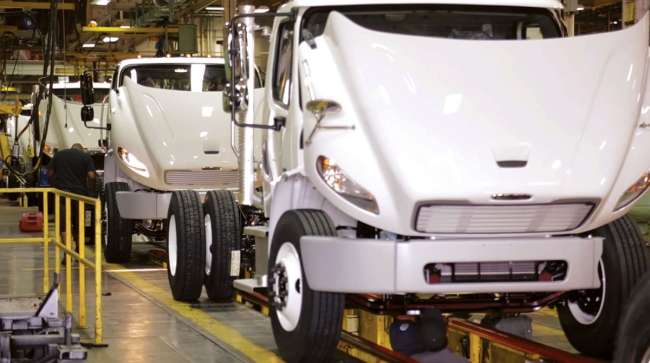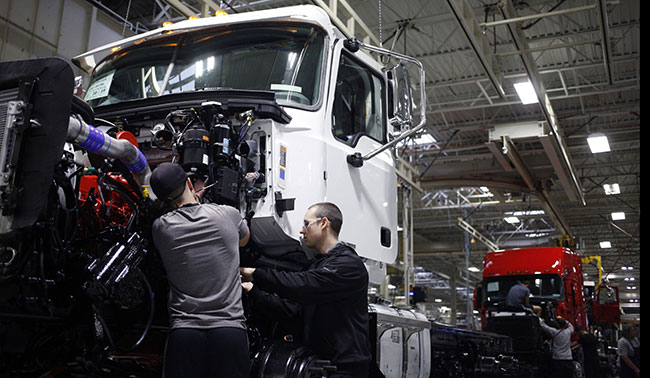Senior Reporter
May Class 8 Orders Fall to 22,900

[Stay on top of transportation news: Get TTNews in your inbox.]
Class 8 preliminary orders for May fell to the lowest point since August, settling just below 23,000 as the industry paused amid little chance to join this year’s orders backlog, ACT Research reported, citing truck makers’ initial data.
In May, orders were 22,900, or 242% higher compared with last year’s pandemic-severed volume of 6,687.
May also slipped 32% compared with April’s 33,630, according to ACT.
Preliminary NA Class 8 net orders in May were 22,900 units, down 32% from April, but a significant 242% higher than May of 2020’s COVID-stricken intake.https://t.co/HRIOJQt8Gm#truck #semitruck #trucking #transportation pic.twitter.com/QWRo5ojrtY — ACT Research (@actresearch) June 3, 2021
ACT President Kenny Vieth estimated there are thousands of “red-tagged” units that are essentially built, but unfinished and waiting for parts.
“Based on anecdotal conversations, we would put the current number of red-tagged units at around 5,000 units industrywide,” he said.
FTR pegged orders at 23,600 based on the preliminary data and calculated there have been 420,000 Class 8 orders over the past 12 months.
“I didn’t expect the May number would be that impressive,” said Don Ake, vice president of commercial vehicles at FTR. “My information is the truck makers are not taking 2022 orders yet, so they are just filling up 2021.”
One fleet executive offered a bittersweet perspective on his latest orders.
“We are very conscious of the fact that we may be purchasing some of the last diesel-powered trucks in our fleet with our most recent order,” Garrett Bowers, CEO of Bowers Trucking and Logistics Inc. in Ponca City, Okla., told Transport Topics.
“We were lucky to stick with our original order of Mack Anthems from Bruckner Truck Sales in Tulsa Okla., in December 2019. We held onto the 25-truck order though the pandemic, while many other fleets were falling out or canceling,” Bowers said. “To date, we have received 12 of our original 25-truck P.O. — largely as a result of the microchip shortage in the manufacturing process.”
Bruckner not only extended the fleet’s price-protection policy through the pandemic, but allowed it another term in 2021, he said.
His 41-year-old company ranks No. 40 on the Transport Topics list of the largest flatbed/heavy specialized carriers in North America. It operates 68 heavy-duty trucks.
“In April, we increased our order to an additional 25 units, anticipated to be received in 2022,” Bowers added. “I think these are very exciting times in the transportation industry. Especially with the evolution of equipment and technology.”
In related news, the Biden administration’s fiscal year 2022 budget request included a proposal for a brand new zero-emission truck investment tax credit (ITC), based largely around incremental cost of the zero-emission vehicle over conventional vehicles.
“The credit can be elected as a cash payment in lieu of investment tax credit,” said Kyle Winslow, federal policy director at Calstart, a Pasadena, Calif.-based clean transportation accelerator.
“A new ITC for zero-emission trucks, and the benefits of making that new credit redeemable as a cash payment in lieu of, has been the primary focus of the Calstart-led National Zero-Emission Truck Coalition over the past year,” Winslow said.

Workers install parts on an engine at the Mack facility in Macungie, Pa. (Luke Sharrett/Bloomberg)
The proposal includes battery-electric and fuel cell electric vehicles from Classes 3 to 8, ranging from at their highest a credit value of $25,000 to $120,000 depending on class, and stepping down. The credit starts in fiscal ’22 and is full value the first three years, and steps down through fiscal ’27. The administration projects outlays over a 10-year window through 2031.
For instance, for Classes 7-8 shorthaul vehicles, the credit is:
- $120,000 per vehicle purchased between Jan. 1, 2022, and Dec. 31, 2023.
- $100,000 per vehicle purchased between Jan. 1, 2024, and Dec. 31, 2024.
- $80,000 per vehicle purchased between Jan. 1, 2025, and Dec. 31, 2027.
For Class 7-8 longhaul vehicles, the credit is:
- $120,000 per vehicle purchased between Jan. 1, 2022, and Dec. 31, 2024.
- $100,000 per vehicle purchased between Jan. 1, 2025, and Dec. 31, 2027.
In the meantime, challenges could affect the availability and production of rare earth materials needed in electric vehicles, a federal lab reported.
President Joe Biden also recently signed an executive order to review supply chains for critical materials, including rare earth minerals — the group of 17 elements like neodymium and scandium that wind up in everything from electric vehicles to phones to fighter jets.
Scientists at the U.S. Department of Energy’s Argonne National Laboratory recently published research on how the supply chains of rare earth minerals respond to disruptions such as natural disasters, labor disputes, construction delays “and — on everyone’s mind at the moment — pandemics,” Dave Bukey, integrated communications lead at Argonne National Laboratory, told Transport Topics.
“The most significant impacts on EV production would be in certain types of supply disruption scenarios that could cause the neodymium magnets used in most electric vehicle motors to become unavailable, which could have a dramatic impact on EV production,” said Matthew Riddle, assistant energy scientist at Argonne.
“We are starting to look into critical materials for lithium-ion batteries,” said Allison Bennett Irion, chair of Argonne’s Advanced Supply Chain Analytics initiative, “such as lithium, cobalt and nickel, which could also have major impacts on EV production if supply is disrupted.”
Want more news? Listen to today's daily briefing below or go here for more info:




